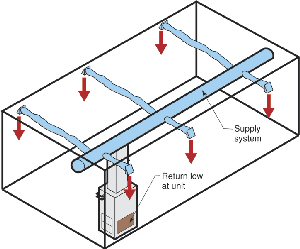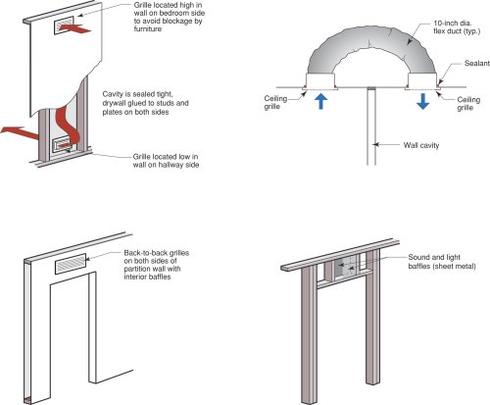This one-story slab-on-grade enclosure is designed for Tucson, AZ (Hot-Dry/Mixed-Dry Climate). The flat roof is insulated with cavity insulation in the roof truss and features a rubber roofing membrane. The 2x6 advanced wood frame walls are insulated with cavity insulation and feature a stucco finish. The slab is left uninsulated.
Enclosure Design
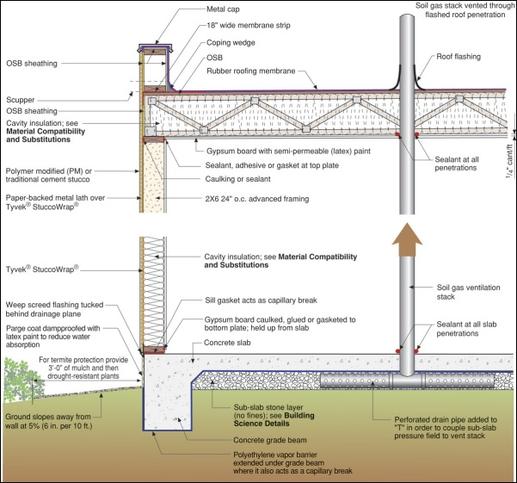
Construction Recommendations
- Foundation: Slab-on-grade
- Above Grade Wall: Wood frame
- Cladding: Stucco
- Attic: None
- Roof: Membrane
Building Science Notes
Ducts in conditioned space - This building profile is designed to accommodate HVAC equipment and ducts in the living space, specifically in dropped soffits and a utility space in the building core. HVAC ducts should not be run in exterior walls or the slab.
Air sealing details at transitions – Air sealing can be particularly difficult, but no less important, at assembly transitions such as top-of-wall/roof assembly junctions and between attached garages and living spaces. These are discussed below because they have proven to be a consistent challenge for high performance production builders.
- Top-of-wall/roof assembly junction – The continuity of an exterior air barrier can be maintained at this junction if the air barrier material (foam insulation or stucco cladding, for example) is used continuously for the wall, soffit, and fascia. The continuity of an interior air barrier can be maintained through a combination of cut foam blocks and sealant/caulk, or spray foam. Note that neither cellulose nor fiberglass (batt or blown) can be used for the air barrier.
- Attached garages – The building enclosure surfaces shared between conditioned space and an unconditioned garage must have a continuous air barrier. See Figure 19 at right and Information Sheets for details in terms of using sealants and rigid insulation to create a continuous air barrier between the attached garage and living space.
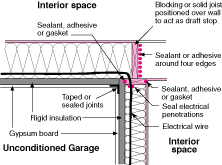
Figure 19
Drying mechanisms – In any climate, vapor control is based on the relationships among the following: the permeability of wall components, the type of cladding (reservoir or non-reservoir), the presence/lack/nature of an air space, and the magnitude/duration of the vapor drive (based on the relationship between the exterior and interior moisture content and temperature differences). The type of sheathing and housewrap used in any wall assembly must be based on an understanding of these inter-relationships. See “Insulations, Sheathings, and Vapor Diffusion Retarders” for more information. This wall assembly permits drying to both the interior and the exterior (depending on the selection of exterior sheathing – see the Building Material Properties Table).
Drainage plane, air barrier, and vapor control – The drainage plane in this wall assembly is the Dupont StuccoWrap® weatherlapped onto the OSB structural sheathing (the paper-backed lath serves as the bond break for the stucco cladding). An annual precipitation of 8 inches (30-year average for Tucson) means that a face sealed stucco cladding can work, but this system is designed with a drainage plane as a “belt and suspenders” approach for long-term durability.
The air barrier is the interior gypsum board installed using the Airtight Drywall approach.
The OSB sheathing in this wall assembly limits drying potential to the exterior, as does the membrane in the "flat" roof assembly. So interior sheathing and finish components must be selected that promote drying to the interior.Rough opening flashing – Window and door flashing details are wall assembly or cladding specific and depend on whether the windows are installed before or after the drainage plane. Refer to the Water Management Guide for more information.
Advanced framing – This wall assembly employs all of the advanced framing methods except alternative shear resistance; that is, structural sheathing is used. See Advanced Framing Details.
Framing on slabs – Installing a capillary break between the sill plate and a concrete slab on all walls—exterior, interior, partition—is good practice. A closed cell foam sill sealer or gasket works well. Alternatively, a strip of sheet polyethylene can be used. This isolates the framing from any source of moisture that may be either in or on the concrete slab (and using sill sealer on all walls maintains wall height exactly the same).
Soil gas ventilation – The sub-slab to roof vent system handles conditions that are difficult if not impossible to assess prior to completion of the structure—resultant confined concentrations of air-borne radon, soil treatments (termiticides, pesticides) methane, etc. The cost of this “ounce” of prevention is well balanced against the cost of the “pound” of cure.
Sub-slab stone bed - The four-inch deep, 3/4" stone bed functions as a granular capillary break, a drainage pad, and a sub-slab air pressure field extender for the soil gas ventilation system. Without it, a soil gas ventilation system is not practically possible and the only capillary break between the slab and ground is the polyethylene vapor barrier.
Thermal barrier – In all but the slab foundation, the thermal barrier is accomplished by cavity insulation. BSC recommends slab perimeter insulation for all slabs, regardless of the heating or cooling load, because the slab perimeter represents a significant thermal bridge that not only affects energy use but also contributes to localized thermal comfort and potential condensation problems. See Termite Control under Field Experience Notes for the rigid insulation detail.
Roofing – Light-colored membrane roofing performs better than conventional dark colored membrane roofing in this climate. See Energy Star's Roof Products List for more information.
Climate Specific Details
- Mechanical systems
- Heating – Sealed combustion hot air furnace. Sealed combustion means that the unit can be located within the conditioned space with no compromise in indoor air quality or combustion safety.
- Cooling - Evaporative cooling is prevalent in Hot-Dry Climates. We recommend refrigerant cooling in high performance homes in this climate region for three reasons:
Refrigerant cooling permits year-round controlled ventilation; evaporative cooling does not.
Evaporative cooling can be prone to moisture and indoor air quality problems without frequent and diligent system maintenance, refrigerant cooling is not.
While there can be a slight energy penalty with refrigerant cooling in comparison to evaporative, this penalty must be balanced against the year-round comfort provided by refrigerant cooling (evaporative cooling has difficulty supplying comfort in high humidity situations), and the substantial water savings associated with refrigerant cooling (a growing issue in mixed-dry climates).
Follow appropriate sizing procedures. See Figure 20 and the Cooling System Sizing Pro.
Figure 20
Ducting - Single return requires transfer grilles to provide path and avoid pressurizing bedrooms, as shown in Figures 21a-d. Appropriate sizing for ducts, including these pressure relief methods, can be found here in the System Sizing.
Figure 21a-d
Controlled mechanical ventilation - Intermittent central-fan-integrated supply, designed to ASHRAE 62.2P rate, with fan cycling controls set to operate the central air handler as much as 33% of the time, but not less than 25 % of the time, occurring within at least every three hours to provide ventilation air distribution and whole-house averaging of air quality and comfort conditions (installed cost: $125 to $150). Include a normally-closed motorized damper in the outside duct with the AirCycler® FRV control (installed cost: $50 to $60). For more information on controlled mechanical ventilation, see controlled mechanical ventilation for more information.
Termite management – Termites are best managed with a three-pronged approach that deals with the three things termites need—cover from sunlight, moisture, and food (wood or paper):
Reduced cover – Keep plantings 3 feet away from the building perimeter, thin the ground cover (wood mulch or pea stone) to no more than two inches depth for the first 18 inches around the building, and maintain any termite inspection zone on the exterior of the foundation above grade.
Control moisture – Maintain slope away from building as shown, carry roof load of water at least three feet away from building, and make sure that irrigation is directed away from the building.
Chemical treatment – Use an environmentally-appropriate soil treatment (such as Termidor®) and a building materials treatment (such as Bora-Care®) for termite-prone near-grade wood materials.
Inter-relationship of first three points – Since a builder and a homeowner’s ability to employ or stick to each of the three strategies above will vary, make sure that an inability to fully employ one strategy is compensated for by complete rigor with the others. For example, if for some reason, chemical treatment of soil or building materials is not an option, then complete rigor in moisture control and ground cover is required.
Landscaping for wildfire control – keeping woody materials of any type, living or otherwise, away from the building is good practice in dry climates where wildfire presents a significant risk.
Field Experience Notes
Termite control – Local codes and interpretations by building inspectors can make details involving slab insulation difficult. We have found that building officials accept the flashing/fibercement board shown in the building profile and in Figure 22.
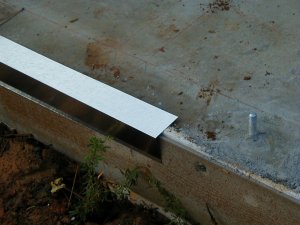
Figure 22
HVAC commissioning – The most efficient equipment means little if the system is not set up and started up properly. Follow high performance start-up procedures. In dry climates, it is generally a good idea to set up the air distribution fan to run a little longer at the end of each cycle to bump up the sensible efficiency.
Location of HVAC outdoor unit – It’s tempting to put the condenser right on the roof where the evaporative cooling unit was, particularly when lot lines are really tight. We do not recommend rooftop location of the condenser for the following reasons: it makes even routine maintenance more difficult; it puts the unit at what is most likely the hottest spot on the entire property; and it introduces more roof penetrations.
Advanced framing - For a technical resource that may help with resistance to advanced framing methods from local code officials, see Building Safety Journal article written by Peter Yost of BSC.
Slabs – In dry climates, it is quite common for builders to use a sand layer in between the polyethylene sheet and the cast concrete to prevent differential drying and cracking problems. This moisture-holding layer should never be placed between the poly and concrete. Differential drying and subsequent cracking should be handled with a low water content concrete and wetted burlap covering. See this technical resource for more information.
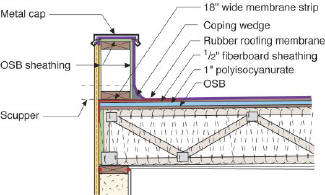
Figure 23
Moving this assembly to Mixed-Dry climates – This “flat-roof” assembly is routinely moved to colder climates without any change in the design/construction of the assembly. We recommend that in any climate where the average monthly temperature for the coldest month drops below 45°F, one of the following four methods be employed to significantly reduce the potential for condensation problems in the structural roof deck (see Figure 23):
Adding rigid insulation above the roof deck to raise the temperature of the roof deck to control condensation. Rigid polyisocyanurate insulation is recommended for its temperature stability. The amount of rigid insulation required is calculated by the climate location. See “Insulations, Sheathings and Vapor Diffusion Retarders."
Spraying rigid foam insulation on the underside of the roof deck and cover with fiberous cavity insulation. The thickness of the spray foam insulation is calculated as in #1 above.
Locating all of the insulation above the roof deck.
Spraying the entire cavity with foam insulation.
Material Compatibility and Substitutions
Interior latex paint - The substitution of low permeability interior finishes (vinyl wall paper, oil-based paints) for latex paint is strongly discouraged as drying to the interior is important in mixed climates.
Building papers with stucco – There must always be two components here—the bond break material and the drainage plane. Although StuccoWrap® is advertised as both a drainage plane material and the layer receiving the stucco, these two materials should never be combined or reversed in this assembly.
Exterior sheathing materials – In this assembly, the reservoir cladding means that a moisture sensitive material such as fiberboard should not be used. Plywood is an acceptable substitution for OSB in this wall assembly. For more information, see the Building Materials Property Tableor “Insulations, Sheathings and Vapor Diffusion Retarders.”
Cavity insulation materials – Acceptable cavity insulation includes any that have a relatively high vapor permeability—cellulose, fiberglass, foam (as long as air sealing is accomplished by a separate component or system when cellulose or fiberglass is used). User discretion can be based on properties other than building science.
Flooring - Because curing concrete releases significant moisture for several months after being cast, we recommend that a low w/c concrete ratio ( 0.45) be used to protect the integrity of finished flooring. We recommend that vinyl flooring not be installed over a concrete slab.
Gypsum wallboard – Areas of potentially high moisture, such as bathrooms, basements, and kitchens, are excellent candidates for non-paper faced wallboard systems (e.g. James Hardie’s Hardibacker®, GP’s DensArmor®, USG’s Fiberock®). In addition, paper-faced gypsum board should never be used as interior sheathing or backer for tub or shower surrounds where ceramic tile or marble (any material with joints or grout lines) is used as the finish.

